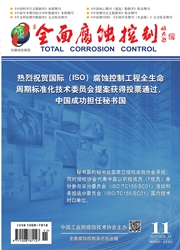

 中文摘要:
中文摘要:
本文以锻态GH4698合金为研究对象经过1次固溶和2次固溶处理,通过与锻态组织进行对比分析了固溶处理对合金金相组织的影响,并探索了不同固溶处理工艺对GH4698合金在模拟海水溶液中电化学腐蚀行为的影响。结果表明:高温锻造后,合金组织表现出晶粒细小组织均匀的回复再结晶特征。固溶处理后,第二相充分溶于基体形成过饱和固溶体并发生明显长大。二次固溶处理主要起到促进细小析出相的长大及后续细小第二相及亚晶界处碳化物的析出。通过腐蚀电流密度的大小表征腐蚀速率的快慢,发现固溶处理会显著影响锻态GH4698合金在NaCl溶液中的腐蚀速率。同一试样的腐蚀速率随浓度增加呈现波动变化趋势,表明是多种影响因素或是腐蚀机制共同作用的结果。锻态、锻态后1次固溶处理以及锻态后2次固溶处理分别在5.5%、3.5%和9.5%NaCl溶液中的耐蚀性能最好。第二相和碳化物所引起的内部腐蚀在3.5%NaCl溶液中的影响最明显,5.5%和7.5%浓度下,随着固溶处理次数增加,腐蚀速率增快,在9.5%浓度下,随着固溶处理次数增加,腐蚀速率减小。固溶处理合金的腐蚀行为存在多种影响因素或是腐蚀机制的共同作用。
 英文摘要:
英文摘要:
To study the influence of different solution treatment on the metallographic structure variation and corrosion behavior of GH4698 in NaCl solution, the metallographic structure and corrosion characteristics of alloys which treated by forging and solution in NaCl solution with different concentrations have been discussed. The results show that there is dynamic recovery and re-crystallization characteristic in metallographic structure of GH4698 alloy after forging; after one time solid solution treatment, there are obviously grain growth characteristic and the second phase fully dissolved in the matrix and form the supersaturated solid solution; after two times solid solution treatment, there is precipitate and the growth of second-phase and carbide in sub-boundary. Indicate the corrosion rate by corrosion current density and find that the effect of solid solution on corrosion rate of GH4698 in NaCl solution. The corrosion rate of each specimen varies with fluctuation for the co-effect of factors or corrosion mechanisms. The alloy of forging, forging+ one time solution treatment and forging+ two timessolution treatment shows their best corrosion resistance in 5.5%, 7.5% and 9.5% NaCl solution. Internal corrosion caused by second phase and carbide is obvious in 3.5% NaClsolution. Corrosion rate rising with the increasing of solution times in 5.5% and7.5% NaClsolution. However the corrosion rate decrease with the increasing of solution times in 9.5% NaCl solution. It is the combined action of factors and corrosion mechanisms.
 同期刊论文项目
同期刊论文项目
 同项目期刊论文
同项目期刊论文
 Robust exponential stability of stochastic reaction-diffusion recurrent neural networks with Markovi
Robust exponential stability of stochastic reaction-diffusion recurrent neural networks with Markovi 期刊信息
期刊信息
